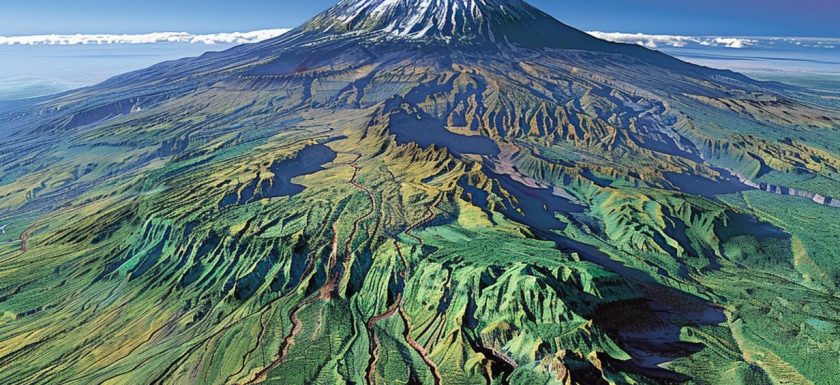
Embarking on a journey to conquer Mount Kilimanjaro is no small feat, and choosing the right route is crucial for a successful climb.
Factors such as physical demands, scenery, crowd levels, and difficulty must all be taken into consideration.
In this article, we will compare the most popular routes up Kilimanjaro – Marangu, Machame, Lemosho, Rongai, and Umbwe.
We will provide an overview of each route, along with the pros and cons to help you make an informed decision for your epic adventure.
Key Takeaways:
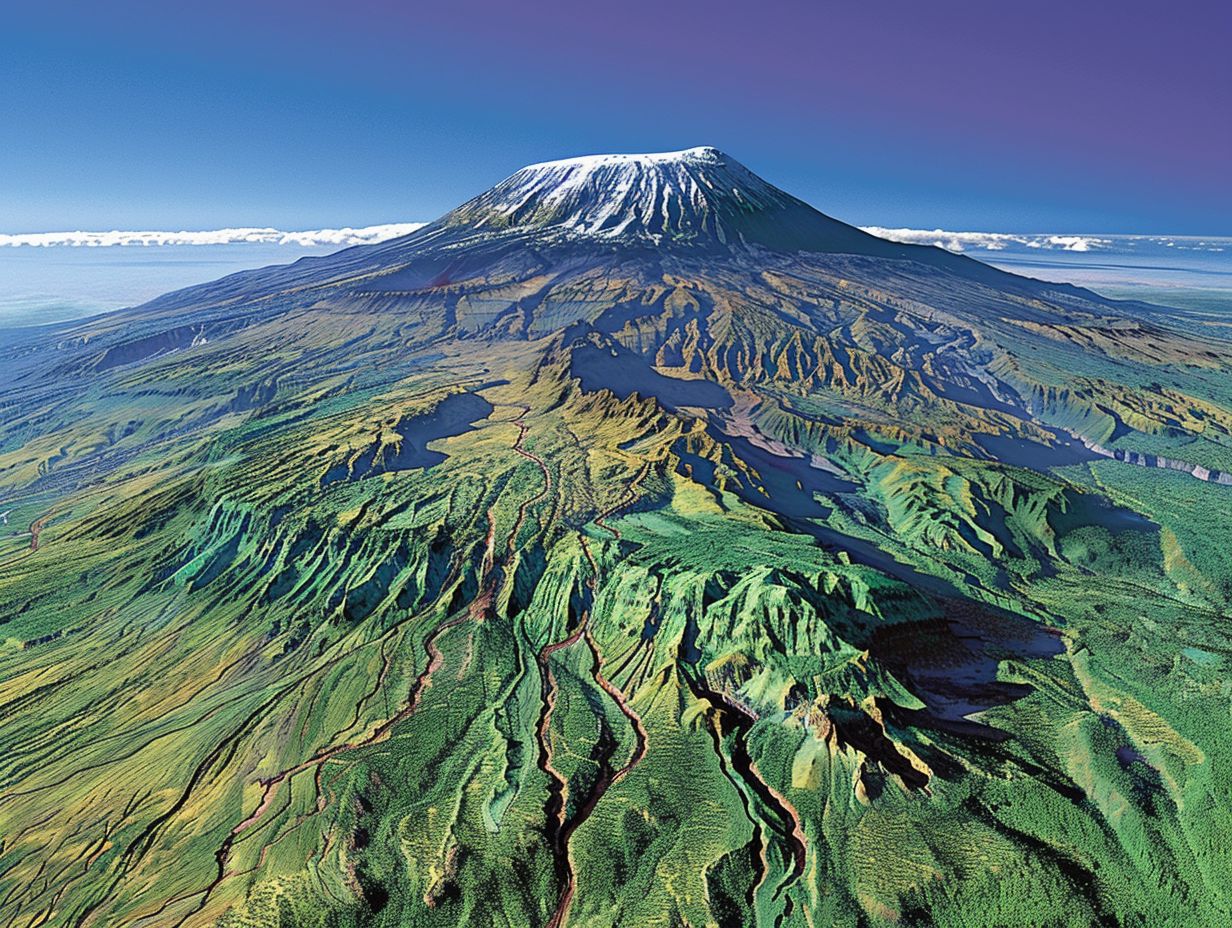
- Consider physical demands, scenery, crowds, and difficulty level when choosing a Kilimanjaro route.
- The Marangu Route offers a more comfortable experience with huts for accommodation, but can be crowded.
- The Machame Route provides a more scenic and challenging trek, but can also be crowded.
Factors to Consider When Choosing a Route
When planning to climb Kilimanjaro, there are several critical factors to consider when selecting a route. These factors can significantly impact your overall experience, success rate, and safety during the climb.
One of the primary considerations when choosing a route is the physical demands each route presents. Some routes are more challenging due to steep inclines, rocky terrain, or higher altitude gains. Acclimatization needs also differ among the routes, with some allowing for more gradual altitude acclimatization, while others require quicker ascent profiles.
The terrain variations between routes can vary significantly, with some offering more scenic landscapes or diverse ecosystems. It is crucial to match the route’s difficulty level and terrain with your own fitness level, acclimatization capacity, and the type of experience you desire.
Physical Demands
The physical demands of climbing Kilimanjaro vary depending on the chosen route, altitude gain, distance covered, and the duration of the climb. Each route presents unique challenges and requirements for climbers to consider.
For instance, the Marangu Route, also known as the ‘Coca-Cola’ route, is considered one of the easier routes due to its gradual ascent and huts for accommodation. In contrast, the Machame Route, known for its picturesque scenery, involves more strenuous trekking but allows for better acclimatization.
Altitude variations on Kilimanjaro range from the lush rainforest at the base to the glacial summit, requiring climbers to adapt to changing oxygen levels. Endurance is crucial, as climbers face long hours of walking each day and steep inclines.
Scenery and Terrain
Kilimanjaro’s diverse scenery and terrain offer climbers a visual feast of natural beauty. From lush rainforests to alpine deserts, each route showcases unique landscapes and wildlife encounters that enhance the trekking experience.
The Lemosho Route, for example, begins in the verdant rainforest at the base of the mountain and gradually ascends through heath and moorland zones, offering stunning views of the Shira Plateau.
On the other hand, the Machame Route is renowned for its diverse landscapes, including the famous Barranco Wall and its stunning views of Mount Meru. As you climb higher, the vegetation changes, giving way to rocky lunar-like landscapes with impressive glaciers glittering in the sunlight.
Crowd Levels
Crowd levels on Kilimanjaro routes can vary significantly, influencing the overall experience of climbers. Routes with higher traffic may lead to crowded campsites, limited accommodation options, and a less immersive wilderness experience.
The impact of crowd levels on the quality of the trek depends greatly on individual preferences.
- For those seeking a more solitary experience, selecting less popular routes like the Northern Circuit or Lemosho Route can provide a sense of isolation and tranquility amidst the rugged beauty of Kilimanjaro.
- On the other hand, climbers looking for a communal atmosphere and shared journey might opt for the busier Marangu or Machame routes, where interactions with fellow trekkers are more frequent.
Difficulty Level
The difficulty level of Kilimanjaro routes varies based on the approach to the summit, steepness of slopes, and altitude challenges. Some routes feature technical sections, while others offer more gradual ascents to the peak.
For example, the Machame Route is known for its challenging Barranco Wall, requiring climbers to navigate steep cliffs with the help of local guides. On the other hand, the Lemosho Route provides a more gradual climb, allowing for better acclimatization and higher success rates.
Summit night on Kilimanjaro is a test of endurance, with climbers facing freezing temperatures and thin air as they push towards Uhuru Peak. The steepness of the final ascent varies depending on the chosen route, with routes like the Western Breach presenting technical challenges that demand mental and physical strength.
Marangu Route
The Marangu Route, also known as the ‘Coca-Cola Route’, is one of the most popular paths to the summit of Kilimanjaro. It is characterized by its hut accommodations, gradual slopes, and the challenging summit night ascent.
The Marangu Route offers shelter in huts along the way, providing a more comfortable experience compared to camping. These huts have basic amenities such as beds and communal dining areas, making it a favored choice for those who prefer not to carry camping gear.
One of the advantages of the Marangu Route is the steady ascent, allowing for better acclimatization. Some hikers find this gradual climb less challenging and may prefer steeper, more adventurous routes.
Accommodation options on the Marangu Route include Mandara, Horombo, and Kibo Huts, each offering a different level of comfort and facilities. Hikers must carefully plan their overnight stays to ensure proper rest and preparation for the summit night.
Overview of Marangu Route
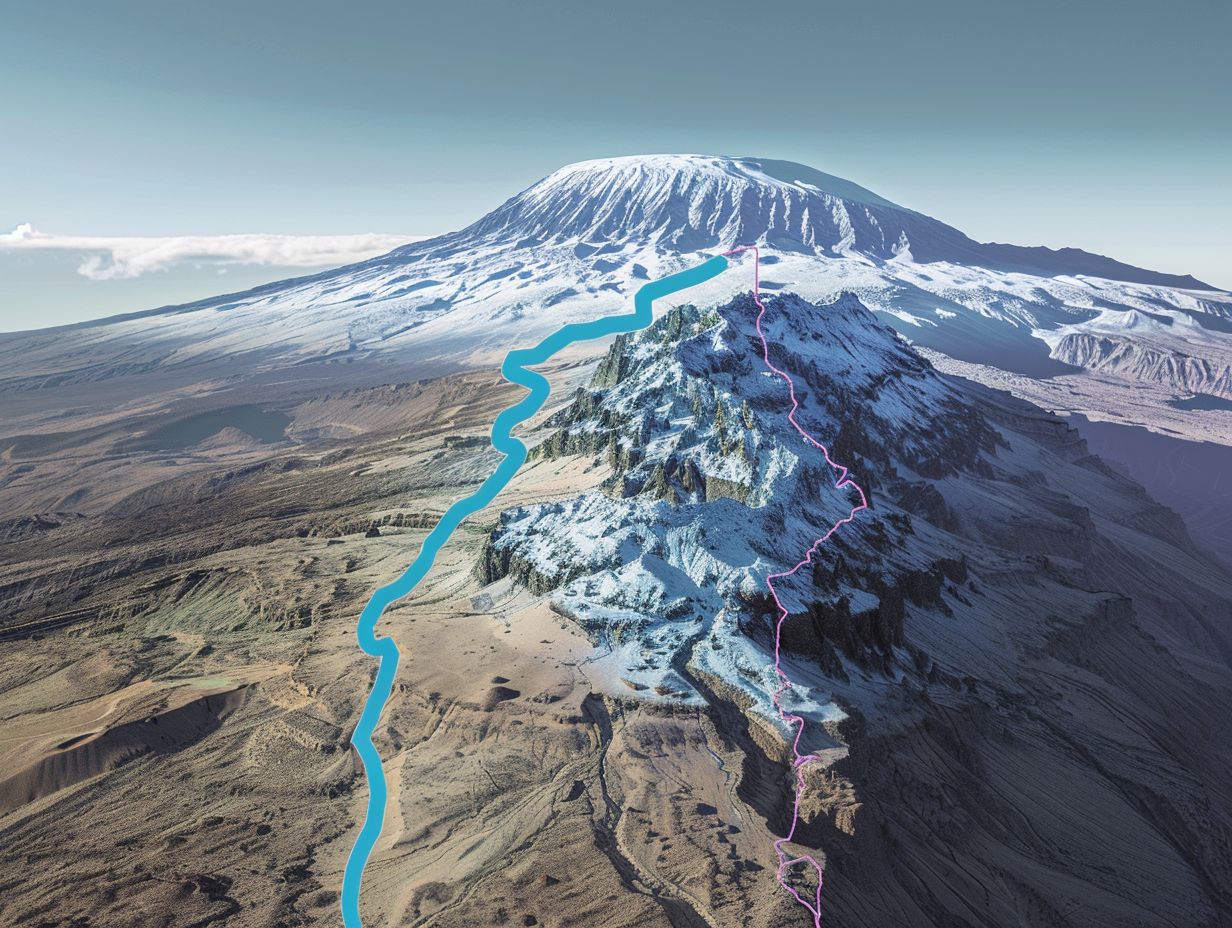
The Marangu Route offers a unique trekking experience on Kilimanjaro with its well-defined paths, hut accommodations, and scenic landscapes. This route is known for its relatively gentle terrain and historical significance.
One of the distinctive features of the Marangu Route is its well-maintained paths that make it an ideal choice for trekkers looking for a manageable challenge. Hut accommodations provided along the way offer a comfortable and convenient retreat for overnight stays, enhancing the overall trekking experience.
The landscape diversity along the route ranges from lush rainforests to alpine meadows, providing trekkers with breathtaking views throughout the journey. The route’s historical significance, including landmarks such as Hans Meyer Cave and the Maundi Crater, adds a sense of intrigue and depth to the trek.
Pros and Cons of Marangu Route
The Marangu Route offers the advantage of hut accommodations, higher success rates due to gradual ascents, and historical significance. It is often criticized for its traffic levels and lack of wilderness experience.
One of the key benefits of taking the Marangu Route is the availability of hut accommodations, providing a more comfortable resting place than camping in tents. This can be a significant advantage for trekkers seeking a bit more trekking comfort or for those new to high-altitude hiking.
The gradual ascent of the route is favored by some hikers as it allows for better acclimatization, leading to potentially higher summit success.
On the flip side, the route’s popularity can result in crowded trails, especially during peak seasons, which may detract from the wilderness immersion that some adventurers seek. The presence of more trekkers can also lead to certain sections feeling congested, making the experience less serene for those looking for a more solitary trek.
Machame Route
The Machame Route, known as the ‘Whiskey Route,’ is celebrated for its stunning scenery, diverse terrain, and high success rates in reaching Kilimanjaro’s summit. Its rapid ascent profile can increase the risk of altitude sickness.
This route offers trekkers a fantastic opportunity to experience a variety of landscapes, from lush rainforests to rocky cliffs and glaciers as they ascend towards Uhuru Peak, the highest point in Africa.
Despite the rigorous challenge of the climb, the Machame Route boasts one of the highest summit success rates due to its proper acclimatization schedule. Trekkers need to pay close attention to their bodies for signs of altitude sickness, adjusting their pace and taking necessary precautions to ensure a safe and successful ascent.
Overview of Machame Route
The Machame Route offers a memorable trekking experience on Kilimanjaro with its varied landscapes, challenging altitudes, and immersive wilderness setting. This route is favored by adventurers seeking a more strenuous climb.
Known as the ‘Whiskey Route,’ the Machame Trail is renowned for its diverse topography, starting in lush rainforests and then climbing through moorlands and alpine deserts before reaching the summit.
The trek presents various challenges from steep inclines to rocky terrain, demanding a good level of fitness and endurance from climbers. Acclimatization plays a crucial role due to altitude variations, allowing hikers to adapt slowly to the increasing height.
One of the appeals of this route is the true wilderness experience it provides, with opportunities to spot unique flora and fauna endemic to the region, enriching the overall adventure.
Pros and Cons of Machame Route
The Machame Route impresses climbers with its breathtaking scenery, comfortable camping accommodations, and positive feedback from trekkers. Its popularity can result in moderate crowding during peak seasons.
One of the most appealing aspects of the Machame Route is the stunning landscapes that trekkers encounter throughout the trek. From lush rainforests to alpine deserts and panoramic views of glaciers, the route offers a diverse range of scenery that captivates adventurers.
The camping facilities along the route are known for their comfort and reliability, providing climbers with a cozy retreat after a challenging day of trekking.
This route frequently receives glowing reviews from climbers who appreciate the stunning views, varied terrain, and overall experience. While the moderate crowding during popular periods may be a downside for those seeking more solitude, the sense of camaraderie among fellow trekkers can also add to the shared adventure spirit of the journey.
Lemosho Route
The Lemosho Route is renowned for its high success rates, scenic beauty, and strategic navigation through various peaks on Kilimanjaro. This route provides a challenging yet rewarding trekking experience.
One of the distinctive features of the Lemosho Route is its record-high summit success rates, which often attract climbers seeking to conquer Mount Kilimanjaro successfully. The navigational aspect of this route offers a blend of adventure and strategy, with climbers having to navigate through diverse peaks on their journey to the summit.
The allure of this route lies in the comprehensive experience it provides, offering climbers a chance to not only conquer Kilimanjaro but also soak in its breathtaking beauty along the way.
Overview of Lemosho Route
The Lemosho Route stands out for its picturesque slopes, diverse wildlife sightings, and strategic approach to Kilimanjaro’s summit. This route offers a blend of natural beauty and challenging terrain.
One of the key aspects that make the Lemosho Route unique is the gradual slope characteristics that provide climbers with a more gradual acclimatization process compared to other routes. This gradual ascent not only enhances safety but also allows for better adaptation to the altitude.
Trekkers on the Lemosho Route are often treated to incredible wildlife encounters, ranging from playful monkeys swinging through the trees to majestic elephants roaming the lush vegetation. The biodiversity along this route is truly astounding, offering a memorable safari-like experience intertwined with the mountain climb.
Regarding summitting Kilimanjaro via the Lemosho Route, climbers benefit from a strategic approach that maximizes the chance of success. This route allows for proper altitude adjustment and acclimatization, increasing the chances of reaching the summit successfully.
The Lemosho Route appeals to nature enthusiasts seeking both a challenging climb and a unique opportunity to immerse themselves in the diverse ecosystems of Mount Kilimanjaro.
Pros and Cons of Lemosho Route
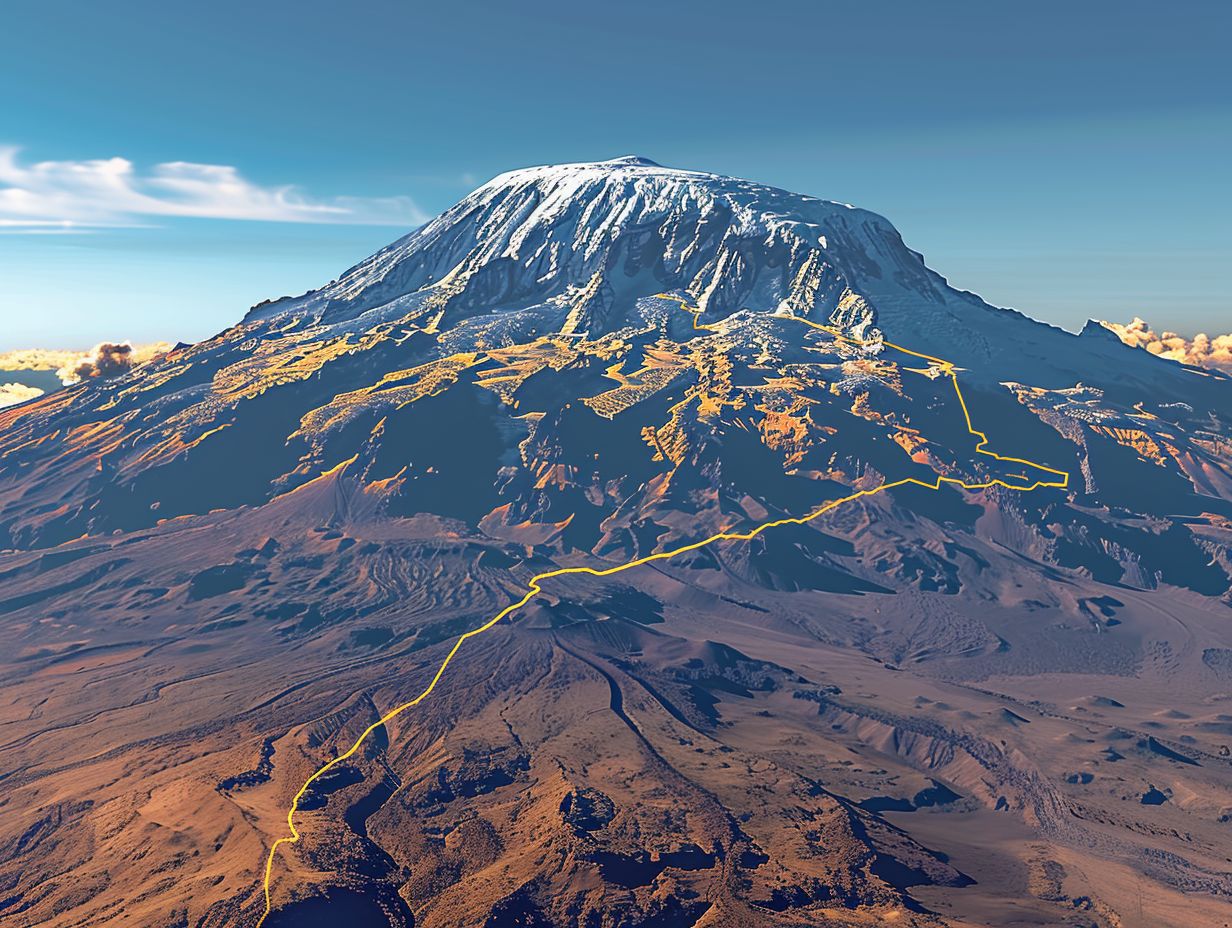
The Lemosho Route offers climbers the advantages of varied altitudes, enhanced safety measures, and peak opportunities for panoramic views. Its challenging terrain may require additional navigation skills.
Altitude acclimatization is essential along the Lemosho Route due to its varied altitudes, allowing climbers to adapt gradually to the changing conditions and reduce the risk of altitude sickness.
With proper safety precautions in place, such as experienced guides, emergency oxygen supply, and evacuation procedures, climbers can feel more secure during their ascent.
Peak panoramas. from spots like the Shira Plateau provide breathtaking views of Kilimanjaro’s summit and surrounding glaciers, rewarding climbers with unforgettable sights. Navigating through the diverse landscapes of moorland, alpine desert, and glaciers demands careful attention and following designated trails to avoid getting lost in this vast wilderness.
Rongai Route
The Rongai Route, known for its serene wilderness ambiance, positive trekker feedback, and commendable success rates, offers climbers a less crowded and more secluded journey to Kilimanjaro’s summit.
One of the key distinguishing features of the Rongai Route is the tranquil wilderness setting that surrounds climbers throughout the trek. Trekkers often praise the peaceful surroundings, which provide a unique sense of serenity and connection to nature during the journey.
Climber testimonials frequently highlight the calming effect of the route, making it an appealing choice for those seeking a more immersive experience in the untamed beauty of Kilimanjaro.
Overview of Rongai Route
The Rongai Route charms climbers with its pristine wilderness environment, minimal traffic, and access to sweeping peak vistas on Kilimanjaro. This route offers a sense of seclusion and natural tranquility.
The allure of the Rongai Route lies in its untouched wilderness immersion, allowing trekkers to connect with nature on a profound level. Unlike busier trails, this path offers a more remote experience where the sounds of wildlife and the whisper of the wind are your constant companions.
As you ascend, the traffic flow decreases, making moments of solitude more common. This tranquility enhances the feeling of being engulfed in the vast wilderness of the mountain, creating a serene setting for reflection and self-discovery.
Pros and Cons of Rongai Route
The Rongai Route offers climbers the advantages of enhanced safety measures, comfortable accommodation options, and strategic summit approaches. The limited route variations may not appeal to those seeking more challenging terrains.
One of the primary strengths of the Rongai Route is its reputation for being one of the safer paths to climb Mount Kilimanjaro, making it an attractive choice for climbers prioritizing safety. The gradual ascent on this route allows for better acclimatization, minimizing the risks associated with altitude sickness.
While the accommodation along the Rongai Route is known for its comfort, with well-equipped tents or huts providing a cozy place to rest after a long day of trekking, some climbers may find the lodge-style experience less authentic compared to camping under the stars in more remote areas.
Umbwe Route
The Umbwe Route stands out as one of the most challenging paths to Kilimanjaro’s summit, known for its steep ascents, rugged terrain, and unparalleled panoramic views of the surrounding landscapes and glacier-clad peaks.
Hikers who tackle this arduous trail are rewarded with spectacular vistas that stretch as far as the eye can see, showcasing the diverse ecosystems and unique beauty of Kilimanjaro. The ascent up the Umbwe Route is not for the faint-hearted, requiring a strong physical and mental fortitude to conquer the relentless steep sections and demanding conditions.
- Over the course of the journey, trekkers are immersed in the wild beauty of the mountain, surrounded by ancient forests, dramatic ridges, and towering cliffs that add to the route’s mystique and allure.
- One of the defining features of the Umbwe Route is its direct approach to the summit, offering a challenging yet rewarding experience for seasoned climbers looking to test their limits and witness the breathtaking sunrise over the African plains from Uhuru Peak.
This route is not just a climb; it’s a transformative adventure that pushes adventurers to dig deep within themselves, overcoming obstacles and fears to reach the pinnacle of Africa’s highest peak, where the world unfolds in a stunning panorama of beauty and accomplishment.
Overview of Umbwe Route
The Umbwe Route challenges climbers with its steep gradients, exclusive camping experiences, wildlife sightings, and rapid altitude gains. This route provides a true test of mountaineering skills and endurance.
One of the unique characteristics of the Umbwe Route lies in its camping arrangements. Campsites along this route offer an immersive wilderness experience, nestled amidst the lush greenery of the rainforest. These campsites provide basic facilities such as tents and sleeping mats, allowing climbers to rest and recharge after a challenging day of trekking.
The route offers remarkable wildlife encounters. Trekkers may have the opportunity to spot a variety of animals, including Colobus monkeys, elephants, and diverse bird species. Such encounters add an exciting element to the climb, making it not only a physical challenge but also a visual delight.
Pros and Cons of Umbwe Route
The Umbwe Route offers adventurers the allure of conquering challenging peaks, receiving positive trekker feedback, and experiencing rapid altitude changes. Its steep terrain can pose risks of altitude sickness for climbers.
Despite the potential challenges of altitude sickness, the Umbwe Route is renowned for its scenic beauty and the sense of accomplishment it brings to those who reach its summit. The route is favored by experienced climbers seeking a more secluded and wilderness experience compared to other busier routes like the Machame or Marangu. Many climbers praise the route for its stunning vistas of glaciers and the iconic Barranco Wall, which add to the allure of the journey.
Frequently Asked Questions
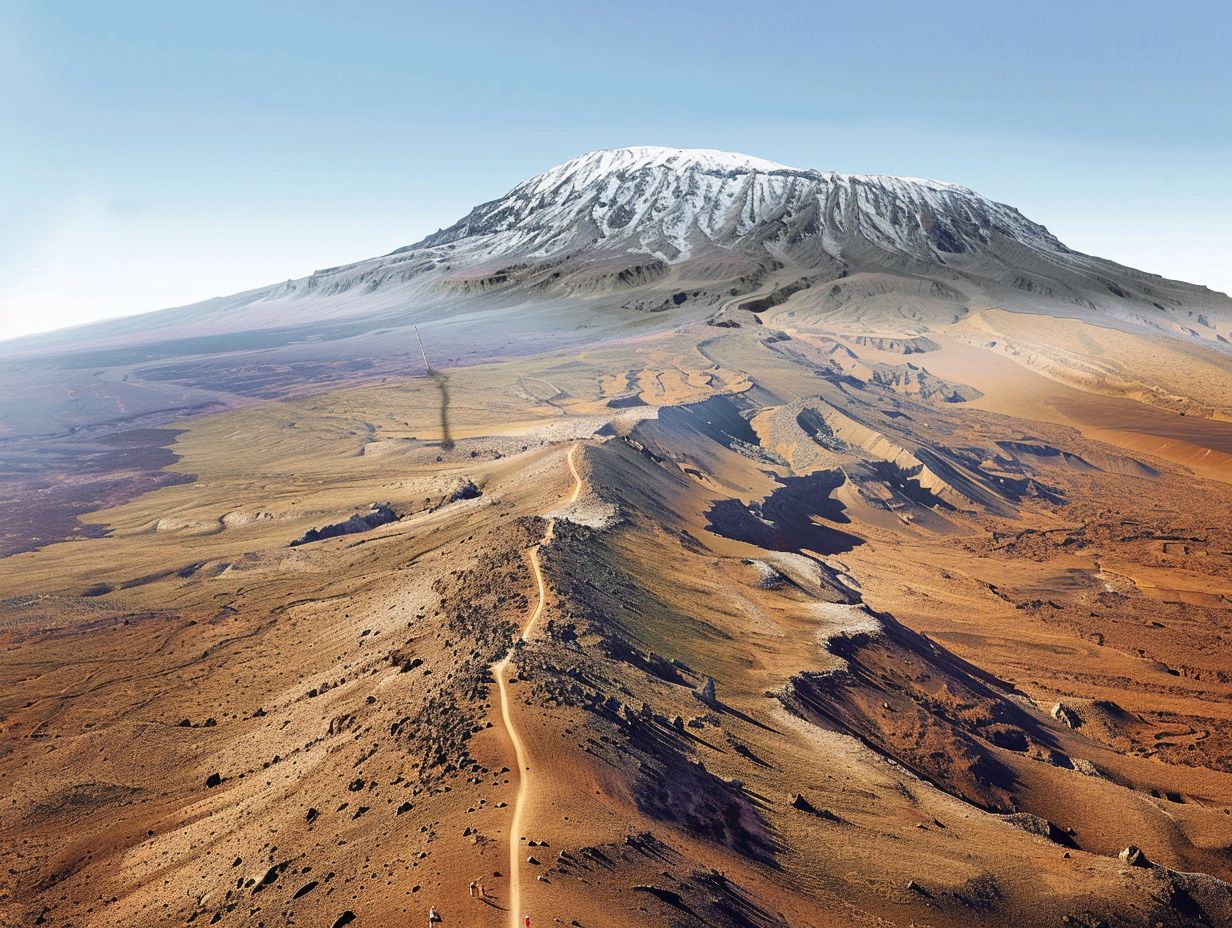
What are the different routes available for climbing Mount Kilimanjaro?
There are seven official routes for climbing Mount Kilimanjaro: Marangu, Machame, Lemosho, Shira, Rongai, Northern Circuit, and Umbwe. Each route offers a unique experience and varying levels of difficulty.
How do I choose the best route for me?
The best Kilimanjaro route for you will depend on your personal preferences, fitness level, and previous hiking experience. It is recommended to research each route thoroughly and consult with a reputable tour operator to make an informed decision.
Which route is the most popular for climbing Kilimanjaro?
The Machame Route is the most popular route for climbing Kilimanjaro, with approximately 50% of climbers choosing this route. It is known for its scenic views and a high success rate of reaching the summit.
What is the difference between the Marangu and Machame routes?
The main difference between the Marangu and Machame routes is the accommodation. Marangu is the only route that offers dormitory-style huts for overnight stays, while Machame involves camping each night. Machame is also considered a more challenging and scenic route.
Which route is the most challenging for climbing Kilimanjaro?
The Umbwe Route is considered the most challenging for climbing Kilimanjaro, with steep and strenuous ascents. It is recommended for experienced hikers only and has a low success rate due to its difficulty level.
Are all the routes equally safe for climbing Kilimanjaro?
Yes, all the official routes for climbing Kilimanjaro are considered safe. However, it is crucial to choose a reputable tour operator, follow safety protocols, and listen to your guide’s instructions to ensure a safe and successful climb on any route.